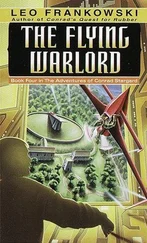Лео Франковски - The High-Tech Knight
Здесь есть возможность читать онлайн «Лео Франковски - The High-Tech Knight» весь текст электронной книги совершенно бесплатно (целиком полную версию без сокращений). В некоторых случаях можно слушать аудио, скачать через торрент в формате fb2 и присутствует краткое содержание. ISBN: , Жанр: Альтернативная история, на английском языке. Описание произведения, (предисловие) а так же отзывы посетителей доступны на портале библиотеки ЛибКат.
- Название:The High-Tech Knight
- Автор:
- Жанр:
- Год:неизвестен
- ISBN:0-345-32763-2
- Рейтинг книги:4 / 5. Голосов: 1
-
Избранное:Добавить в избранное
- Отзывы:
-
Ваша оценка:
- 80
- 1
- 2
- 3
- 4
- 5
The High-Tech Knight: краткое содержание, описание и аннотация
Предлагаем к чтению аннотацию, описание, краткое содержание или предисловие (зависит от того, что написал сам автор книги «The High-Tech Knight»). Если вы не нашли необходимую информацию о книге — напишите в комментариях, мы постараемся отыскать её.
The High-Tech Knight — читать онлайн бесплатно полную книгу (весь текст) целиком
Ниже представлен текст книги, разбитый по страницам. Система сохранения места последней прочитанной страницы, позволяет с удобством читать онлайн бесплатно книгу «The High-Tech Knight», без необходимости каждый раз заново искать на чём Вы остановились. Поставьте закладку, и сможете в любой момент перейти на страницу, на которой закончили чтение.
Интервал:
Закладка:
Sir Miesko and Lady Richeza met us at their lands and the party went its way along our mutual border, with Count Lambert pointing out the landmarks to all and sundry. In the days before accurate surveying, this was the accepted way to record boundaries.
Baron Jaraslav and Sit Stefan did not meet us at the appointed time and place. We stopped and unpacked lunch while we waited for them, but even after a leisurely dinner, we were still waiting. Count Lambert was getting angry. "Sir Daniel! You did go to them yesterday, didn't you? You told them to meet us here and now?"
"Of course, my lord."
"Well, damn them!"
"There have been hard feelings between them and me, my lord," I said.
"They can hate you all they want, but they can't disobey their liege! Mount up! We'll go without them! Sir Miesko, stay with us as a witness."
So we finished my borders without Sir Stefan being along. In later days, I sometimes wondered if Lambert didn't assign me some of the baron's lands just to spite him. One day that border would cause me a good deal of grief.
On the trip back to Three Walls, we fanned out in hunting array and with luck took a wild boar and a bison. This was good because I had no meat in my larder with which to feed my guests, and the nearest supermarket was seven hundred years away.
It was dusk when we got back, and Yashoo had the apartment building half up. After all, it was a simple matter of assembling precut pieces, like putting together a huge tinker-toy set. I had checked every piece myself, so of course they fit right together.
Count Lambert was awestruck. "They did this much without your being here? I might as well concede our bet right now. I'll ship your twenty loads of cloth as soon as I return to Okoitz."
"I'll take it in medium-grade linen, my lord."
That gave us curtains and a spare set of sheets.
In the summer, everyone including me went barefoot, but with cold weather coming on, the workers started making shoes for their families. The usual peasant footwear was made of birch bark. You wrapped your feet in rags and laced on soles of bark with leather thongs. The soles lasted a week or two and then you needed new ones.
At first, I was saddened that this was all they had, but then I did some time studies on what was required to tan leather and what was required to cut new soles out of birch bark. A man could cut a set of bark shoes for his entire family in less than an hour. Tanning a hide with medieval methods took months, and leather soles didn't last out the season.
It was over fifty times cheaper to wear birch bark. I suspect that leather shoes became popular only when birch trees became rare. But birch trees were not that common on my lands. I had some birch groves planted, but for a few years we were buying birch bark. I found that it was useful for writing paper as well as shoes, and far cheaper than parchment.
By the time the first snows were flying, our basic living quarters had been completed. Well, we never stopped building, but the apartment house was up and the plumbing was in. I suppose I should describe it.
The building was a hundred ninety yards long, reaching from cliff face to cliff face, and was eighteen yards wide. Structurally, it was really five buildings, with firewalls between each.
The basement, with thick wooden fire doors, eventually to be sheathed in iron, stretched the full length. Because of the slope of the land, it was mostly exposed on the outer side, but it had no windows. From outside the valley, it was a solid masonry first floor. The basement was mostly in dry-food storage, except that the brewery was relocated there from its temporary building. A short tunnel sloped downward from the basement to the icehouse.
The first floor contained the passageway to the main (and only) gate, and off this passageway was a ramp down to the basement. Incoming food supplies could go directly into storage. Next to the gate was the main bathroom, which had showers, sinks, a hot tub, and a dozen flush toilets.
Then came the laundry room, mostly more sinks and draining racks. I'd had some wooden scrub boards made, a major improvement over the local practice of beating dirty clothes between two rocks. After all the trouble I'd had wheedling cloth out of Count Lambert, I had no desire to see it beaten to shreds by some ignorant women.
After that was the kitchen, where the stoves also heated the water for the other plumbing facilities. More porcelain sinks were dedicated to the business of washing dishes.
Our only source of water was the mine. We split small logs, burned them hollow, then tied- them together to form a pipe. A trench was dug following the contour of the land, gently sloping from the mine to the apartment house. The wooden pipes were carefully fitted together in it and packed in clay to slow leakage.
The water seemed pure enough all summer, but I knew that would change once we hit coal. We had plenty of water head, so we built three big filters, each twelve yards high, one of gravel, one of crushed limestone and one of sand. Our water had to flow through all three before it got to us. The filtration system was probably overkill, but I had no way of testing the purity of the water, and an epidemic could wipe us out.
Below the filters was a big stone reservoir, and like everything else in the water system, it was covered with at least a yard of dirt as an insulator. A frozen waterline would have been a major nuisance.
The biggest room in the building was the dining room. It was two stories tall and could seat a thousand people. It stretched across two of the separate structures, right through the firewall and had a huge stone arch in the middle of it. I worried about this breach in our fire defenses, but it seemed important to me that we should all eat together. I salved my conscience by installing two fire hoses near the archway. A balcony ran around the second floor, connecting to the staircases going up.
The second floor went between the two-story gate passage and the dining room. It contained the nursery, the schoolrooms, and our library, once we had enough books for it to deserve that title. It also contained the store. There you could buy all of the sundries and small luxuries that most people wanted.
That was a major innovation, since except in the larger cities, you could only buy things when a peddler happened by. Sometimes housewives went for months without being able to buy pins or needles, so they tried to keep a small supply of money for buying such things whenever they were available. They called this fund their "pin money."
Since we bought in quantity and our markup was only a hundred percent, instead of the usual three hundred, our prices were generally much less than a backpacking peddler could sell for. Yet it was profitable, since one sales girl, Janina, ran the place, and volume was decent.
Prices were marked and that's what things sold for. No haggling allowed.
We treated our vendors the same way. We requested bids, specifically stating the quantities and qualities desired. We always bought from the lowest bidder, and if it turned out later that the product was substandard, we didn't ask him to bid next time. These business methods were denounced from all quarters, but since it was profitable to do business with us, our suppliers eventually came around.
Before long, where the town guilds let us get away with it, each of the Pink Dragon Inns had a similar store. Where they didn't, we often set up a store just outside the city limits, and ran it on a breakeven basis. We busted more than one guild that way, but in so doing we drastically raised the standard of living.
Above the gate were my own quarters, with a small restroom, two toilets and two sinks.
Sir Vladimir stayed at my apartments, as did Krystyana, her four main ladies and a varying number of other girls.
Читать дальшеИнтервал:
Закладка:
Похожие книги на «The High-Tech Knight»
Представляем Вашему вниманию похожие книги на «The High-Tech Knight» списком для выбора. Мы отобрали схожую по названию и смыслу литературу в надежде предоставить читателям больше вариантов отыскать новые, интересные, ещё непрочитанные произведения.
Обсуждение, отзывы о книге «The High-Tech Knight» и просто собственные мнения читателей. Оставьте ваши комментарии, напишите, что Вы думаете о произведении, его смысле или главных героях. Укажите что конкретно понравилось, а что нет, и почему Вы так считаете.










